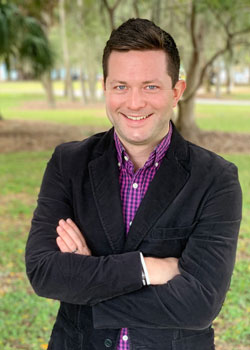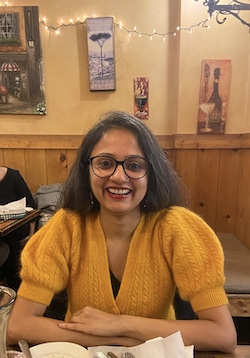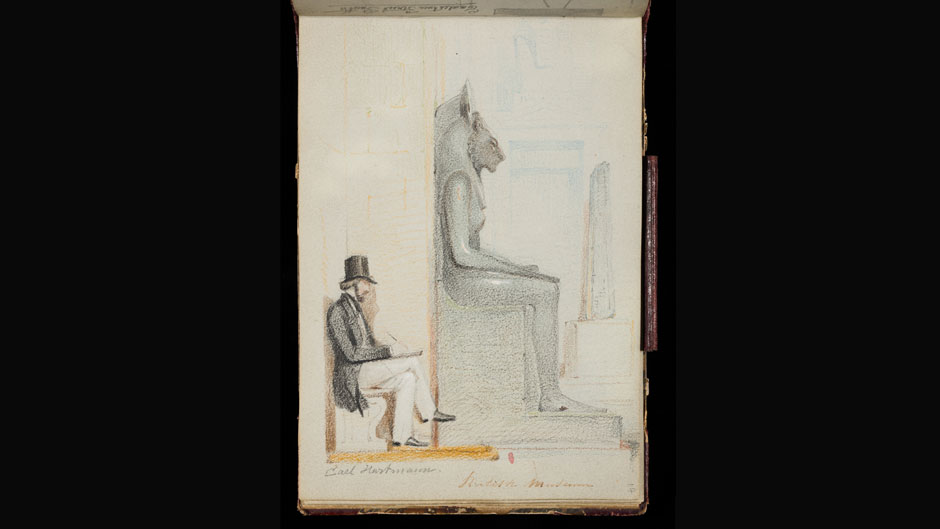Every summer, faculty members and graduate students from arts and humanities fields at the University of Miami College of Arts and Sciences conduct research for scholarly articles, books, and creative endeavors. Depending on the project, the research might involve visiting historical sites, poring over archival materials, or conducting interviews. Here are two examples of the research projects this summer.
Examining 19th-century sketchbooks
Nathan Timpano, chair of the Department of Art & Art History, traveled to the Fitzwilliam Museum at the University of Cambridge in late May to conduct research on Carl Hartmann, a 19th-century German expatriate artist who lived in England. Timpano spent a week in the museum’s special collections, examining and photographing Hartmann’s sketchbooks for a scholarly article.

Timpano, who specializes in European modernism, initially became interested in Hartmann’s work when he came across the only digitized image of a Hartmann sketch, which depicts a man drawing an ancient Egyptian sculpture at the British Museum. What stood out to Timpano was that the posture of the man in the sketch mirrors the posture of the sculpture.
“That was a really interesting image to me, so I wanted to go to the Fitzwilliam, which owns his sketchbooks,” Timpano explained.
When Timpano arrived at the museum and began looking through the sketchbooks, he saw that Hartmann had captured many scenes from daily life in London. His sketches included drawings of a homeless person, women taking their children to the park, and an English gentleman poking what appeared to be a drunk person passed out on the ground. While art historians typically trace the origins of European modernism—which is characterized in part by images of daily life—back to 1860s Paris, Timpano found that Hartmann’s sketchbooks from the 1840s indicate the movement likely began earlier.
“I think we can push this sort of discourse of modernism much earlier, and we can leave Paris,” he said. “We can begin to see that lots of different artists, who are also expatriates moving around Europe at this time period, are experiencing this desire to be a ‘part of the crowd’ and work like artists-journalists in order to really capture the immediacy of modern life.”
Setting the scene in London
Komal Singh, a graduate student in the Master of Fine Arts in creative writing program, traveled to London, England, at the end of May to conduct research for a novel.

Singh had never been to London before, but her novel is about two Indian men who move to London in the 1950s and fall in love, and she wanted to give her writing a strong sense of place. So, she applied for research funding from the Department of English & Creative Writing and the Graduate Activity Fee Allocation Committee to cover the costs of her trip.
In London, Singh visited numerous places that she plans to include in the novel, including Imperial College London, where her protagonist studies, St. Paul’s Cathedral, and Hyde Park. At Imperial College, a historian gave Singh a tour of the campus and pointed out the buildings that date back to at least the 1950s. Singh also met with an alumnus, who told her stories about what campus was like during that period.
“Imagining those places and trying to imagine those chapters and those scenes has been really helpful,” she said. “I think it’s given my novel a strong sense of place.”
Singh is also drawing on her father’s experience living in London and attending Imperial College for inspiration. Singh’s father passed away when she was a child, but she has some of his letters, and she was able to retrace some of his steps, including visiting the house where he lived while he was studying in England.
After returning from her trip, Singh said she feels ready to dive into writing the novel, which will be her master’s thesis.
“I’m feeling really inspired to write, and I think that’s exactly what I wanted,” she said. “So, I’m so grateful for that.”

